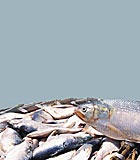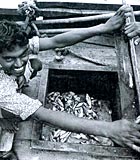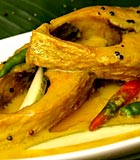 If you can wangle your way into it—I couldn’t— the best place in Kolkata to eat hilsa, by popular opinion, is the exclusive Bengal Club. But Dewan’s kitchen at the Park is not far behind. If you can wangle your way into it—I couldn’t— the best place in Kolkata to eat hilsa, by popular opinion, is the exclusive Bengal Club. But Dewan’s kitchen at the Park is not far behind.
My hilsa education got suddenly intensive under one of his lieutenants, Vasanthi, whose relaxed, toothy grin completely belied her swift hands, her alert eyes, and her martinet manner with a gangling assistant. ‘First, we learn to cut.’
Cutting into a hilsa feels very much like cutting into a very firm, fresh tomato. First a swipe near the neck, then near the tail, and then longitudinal cuts along the sides to peel away the fillet from that side of the fish. This particular hilsa had gorgeous, pink, slightly marbled flesh. ‘Each fillet has a little black area at the bottom, lining the belly of the fish,’ said Vasanthi.
‘Cut that off. It tastes of nothing.’ With another fish, we lopped off the head and, through the digestive orifice, scooped out a mass of congealed blood and hilsa innards. Then we cut the fish into thick slices—what Vasanthi called ‘curry cuts’—to fry. ‘In Bengal, we keep the fins on, we don’t cut them off,’ said Vasanthi. ‘And look here, this is the roe. You can prise it out and fry it up with mustard, onion and green chillies.’ Around the liver sat ruddy flaps of fat, sign of a hilsa that had led a contented life. ‘That liver would be great to fry.’
Somebody, somewhere, must have thrown a switch at this point, because Vasanthi’s actions moved up two gears, and as she whipped between ingredients, my notes began to get scratchier and scratchier. For a baked dish of mint hilsa, she salted one fillet, mixed some mint chutney with what must have been curd (although my scribbles say ‘crud’), mustard oil and desiccated coconut, and marinated the fish in the mixture for ten minutes. She popped the covered plate into a microwave set for eight minutes, power-napped for three seconds, and then turned to the shorshe ilish.
Even on warp speed, Vasanthi made the best shorshe ilish I ate in all my days in Kolkata, days that were so full of shorshe ilish that they now seem to meld together in memory into one bright yellow, mustardy, sinus-rattling streak. ‘To make the mustard paste ahead of time, you soak black and yellow mustard in water, with chillies, for half an hour, and you grind that into a paste.
Not too fine, just grainy,’ she said. To that paste, she added curd, turmeric, salt and lemon. ‘Add that immediately after grinding,’ she warned sternly, somehow sensing that I was exactly the sort of person to dally with a curd-lemon-turmeric mixture in my hand. ‘Delay it even by a few seconds, and the paste turns bitter.’
In a wok, she heated mustard oil and then added, in succession, the mustard paste, water, slices of halved green chillies, salt, quartered tomatoes, and finally, two curry cuts of the hilsa. While the shorshe ilish slowly simmered its way to completion, Vasanthi rolled two other cuts of the fish in the mustard paste and allowed them to marinate.
 When they were ready, she wrapped them in banana leaves and let them steam in a colander for twenty minutes, like two fat gentlemen, draped in Turkish towels, sweating in a sauna. ‘This is ilish paturi, a very popular, very classical dish,” she said. The fish were barely in the colander, and she was already tracing patterns on the cutting board with her knife, itching to move on. When they were ready, she wrapped them in banana leaves and let them steam in a colander for twenty minutes, like two fat gentlemen, draped in Turkish towels, sweating in a sauna. ‘This is ilish paturi, a very popular, very classical dish,” she said. The fish were barely in the colander, and she was already tracing patterns on the cutting board with her knife, itching to move on.
Where Vasanthi really came into her own was in deboning hilsa fillets, a practice that has become popular only in the recent past, to tempt inept non-Bengalis who cannot sieve bones in their mouths. Laying the steamed, softened, mintcrusted fillet flat, she cut it into four long quarters. Then, pressing down hard with her knife, she moved an entire quarter of meat off its skeleton.
This is a tricky maneuver; you can take away too little flesh and leave much of the hilsa still sitting on its bones, or you can scrape too hard and take dozens of little thorn-bones out with the flesh. Vasanthi wielded her knife with the delicacy of an archaeologist dusting skeletal remains, careful to leave behind nothing but bone.
The final act was also the most straightforward. Firing up another burner with a loud ‘whooooomph,’ Vasanthi set on it a non-stick pan laced liberally with mustard oil. Into that went two cuts of hilsa, dusted with just salt and turmeric, to be fried until a golden-brown sheath crept across the surface of the fish. The fish she spooned out, and the oil she set aside.
The hilsa is a naturally fatty fish, and in a wok, the heat forces its oils out, to mix with the mustard oil. The hilsa-enhanced mustard oil is worth saving to flavour food or even to mix simply with rice, as many Bengalis do.
Vasanthi’s plump hilsa, on the day, were from Bangladesh, and what they seemed to lack in sharp natural flavour, they made up for in texture. The paturi, unwrapped like a Christmas gift, flaked away in soft layers, its creamy flesh touched with the mustard and tempered by the damp, green taste of the banana leaf. The fried cuts of hilsa, under their crisp swaggers, were softies at heart, fresh and warm. I may have done the shorshe ilish some injustice, though. Entranced by its grainy, wicked gravy, I neglected to take any more than passing bites of the fish, although its oils—essence de hilsa—had swept like a marauding army through the gravy anyway.
 My vigilance lulled by a gourmandizing stupor, I could thus turn to the deboned mint hilsa, knowing that even the most careless of bites wouldn’t result in bleeding gums or a lacerated tongue. But after many days of eating hilsa for breakfast, lunch and dinner, my bone-seeking sense seemed to remain automatically alert, and that turned out to be a blessing. In one—and only one—mouthful of hilsa, I bit down gently and landed upon a mass of thorns in the middle of the flesh, emerging from the fish in deadly little tendrils. My vigilance lulled by a gourmandizing stupor, I could thus turn to the deboned mint hilsa, knowing that even the most careless of bites wouldn’t result in bleeding gums or a lacerated tongue. But after many days of eating hilsa for breakfast, lunch and dinner, my bone-seeking sense seemed to remain automatically alert, and that turned out to be a blessing. In one—and only one—mouthful of hilsa, I bit down gently and landed upon a mass of thorns in the middle of the flesh, emerging from the fish in deadly little tendrils.
I suspended chewing and pondered the situation. Then I began to work at the mouthful of fish with my tongue, holding the bones steady against my teeth or the roof of my mouth and coaxing hilsa off them in patient little moves. To an observer, I must have resembled a cow meditatively considering its cud. I was left, at the end of my exertions, with just a jumbled clutch of bones, which I neatly deposited to one side of my plate. I ate the rest of my mint hilsa in a glow of satisfaction. It was one of the proudest moments of my life.
From Following Fish – Travels Around the Indian Coast by Samanth Subramanian (Penguin Books India, 2010). Excerpted with permission of the author and Penguin Books India.
Samanth Subramaniam is a journalist who prefers the long-form, narrative version of journalism—waning today, but still rewarding and revealing to both writers and readers. Following Fish won the Shakti Bhatt First Book Prize in 2010.
|

